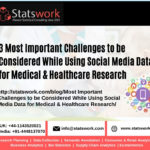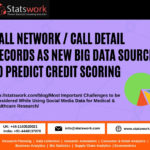How Twitter Can Be Used As A Data Source For Economic Research: Critical Review From The Selected Economic Studies
In Brief:
- Today online social media platforms such as
Twitter, Facebook or Youtube shield a big share of the wide-ranging digital
communication. Different software tools allow the assemble of information about
users and the collection of data about their communication behavior. Mainly, the
microblog Twitter provides manifold opportunities in data analysis to its
functionality and the availability of appropriate software. - In spite of these chances and a wide range of
studies about the use of Twitter for different disciplines, the analysis of
Twitter data and its contextualization within the scope of Foresight projects
is hardly discussed in scientific literature.
A critical review on Using
Twitter as a data source: an overview of social media research tools (2019)
by Wasim Ahmed.
Research by Wasim
Ahmed(2019) presented an influence
on latest developments in digital methods, methodologies for researching
Twitter and other social media platforms. Ahmed gives an overview of the main
trends in research methodology, specially how to use Twitter data efficiently
in given a multitude of methodologies. Along with his list of the various methods for coding and examining social media data, he offers
an extensive listing of the tools needed to pull preferred data from social media accounts – all of which seems a little scheming for some reason in its
language. Things like disabling difficulty in accessing old data using
something called “web-scraping” is more informative.
An overview of tools for 2019

The introductory paragraphs of the reading contains a lot of research
methodology – looking at the research question in more detail, the subjects,
determining factors of influence, methodological approach, statistics together. The study used a mix of
methodological data collection (qualitative and
quantitative). Insertion of standard deviation and mean values began to hold
more consequence; reliability scale values; open-ended, labeled and coded
qualitative data – all of which was made more comprehensible having looked at
the Ahmed article which gave an indication of thematic analysis, with the
quantitative being of experimental design.
There are also a number of research methods that Ahmed mentioned, such
as Netnography and Digital Ethnography, which deliver frameworks for directing
research in the online world. Netnography, for example, can be based on
downloading data straight from a social media platform, perceiving personal
observations of an online community, and interviewing social media users. Besides,
there are also a number of specific means for the data analysis of social media
data summarised in Table below.
Overview of research methods
| Method | Description |
|
Content Analysis |
Content analysis can be used for systematically labelling text, audio, and/or visual communication from social media, and can provide a numerical output. It is fine to take a systematic random sample of between 1% to 10% of the dataset depending on the volume of data retrieved. |
|
Thematic Analysis |
Thematic analysis involves a rigorous process in order to locate patterns within data through data familiarisation, coding, and developing and revising themes. Thematic analysis may also be known as discourse analysis. Similar to content analysis it is fine to take a systematic random sample of between 1% to 10% of the dataset depending on the volume of data retrieved. |
|
Social Network Analysis |
Social network analysis can be used to measure and map the relationships between individuals, organisations, Web Pages, and information and/or knowledge entities. |
| Machine Learning |
Machine learning is a type of artificial intelligence which allows computers to learn without being programmed. It may also involve humans labelling a subset of data and allows the computer to learn and code the remainder of the data. |
|
Semantic Analysis (Linguistics) |
Semantic analysis may examine the meaning of language used and also the relationship between occurrences of words, phrases, and clauses. A useful presentation which uses semantic analysis to examine Twitter can be accessed here. It describes a study by Dr. Mark McGlashan. |
|
Time Series Analysis |
Time series analysis is rarely used a method within itself and is usually combined with other methods. It plots the frequency of social media across time. It is often used to complement other types of analysis. My PhD thesis provides an example of utilising time series analysis alongside other research methods such as content and thematic analysis. |
In searching the role of the participants explored in this study, I was
considering if the author assumed of how personal history may have played an
important role in consequences of the data analysis. While
social media usage was documented using some elementary ranked questioning, the
author never mention the impact of a participants passed social
media interactions. I am left to contemplate how a participant’s
associations and reactions might be transformed if they had practiced
cyber-bullying or had any other important negative interaction on social media
in the years prior to being part of this study.
Conclusion
As Diana Forbes remarks in her research article, “Professional Online
Presence and Learning Networks: Educating for Ethical Use of Social Media”,
“In teacher education, uses of social media include the production and
sharing of content, discussion, and interaction with content analysis, and
collaborative connection with other social media users” (Forbes, 2017).
Twitter is fetching an avenue for professionals to share their
learning, ask questions, and develop a social network in their field of
interest. Users are fortified to use social media to comprehend and communicate
ideas which encourages openness by making research and possessions available to
anybody who is concerned. It is now rare to show up for a workshop or
conference where there isn’t a hashtag where contributors can share their
experiences and instants of learning. In addition to being a place where groups
can assemble and share ideas, it also allows as a ‘backchannel’ of statement
with or among people (Forbes, 2017).
I agree with the overall result of this study. I think Twitter has a
particular benefit because of the way that the podium is set up for academic
purposes. As Wasin Ahmed writes in his recent article, “Using Twitter as
a data source: an overview of social media research tools”, that
“Twitter remains the most widespread platform for academic research.” As divergent
to Instagram, Facebook, and Snapchat – where they are keen towards people sharing
their own personal experiences, instead of ideas. By looking at what
people post, you can make generalities about someones professional reliability
as well as pull data to gather information on a topic. I appreciate Dr. Valerie
Irvine’s presence on Twitter as she not only bonds information and research
connected to what we are discussing in class, but also involving us to other
people to progress our Personal Learning Network, and engaging in conversation
with peers in the field.
Learn More:
- The use of Twitter for knowledge exchange on sustainable soil management, 2019, Jane Mills.
- Linking Twitter and Survey Data, 2019, Tarek Al Baghal
- Harnessing stakeholder input on Twitter: A case study of short breaks in Spanish tourist cities, 2019, EnriqueBign
- Literature vs. Twitter: Empirical insights on customer needs in e-mobility, 2019, NiklasKüh


 Previous Post
Previous Post Next Post
Next Post